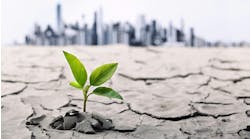This information was accurate at the time of publishing, March 3, 2020. We are monitoring and updating as new information is available.
The spread of COVID-19, or coronavirus, has upended the travel industry and interrupted normal operations at any facility where public gatherings are held or where a large amount of people congregate, including office buildings, airports and meeting and convention spaces.
U.S. and international public health organizations have issued guidelines for basic precautions that should be undertaken to help ensure healthy environments, but officials are still scrambling to gauge both the severity of coronavirus and specific actions that should be taken to combat its spread.
Facilities managers who oversee buildings where large numbers of people gather should implement a risk management strategy to help ensure both the safety of people and guard against any potential legal repercussions related to preparation, especially in the meetings and conventions industry.
The Centers for Disease Control (CDC) recommends basic strategies to improve safety for employees and visitors alike.
The agency's guide for employers recommends making sure hand sanitizer containing at least 60% alcohol is continually stocked at numerous locations within a facility. Portable sanitizer stations are easy to set up in high-traffic areas. Provide plenty of tissues and no-touch disposal receptacles. Posting signage that reminds people to wash their hands and take other precautions is also key.
Areas that have a high degree of interaction with people should be frequently cleaned and sanitized. Custodial staffs should prioritize repeated disinfection of “hot spots,” or high-touch surfaces that come in contact with many people. A new primer on COVID-19 issued by OSHA recommends best practices for routinely cleaning and disinfecting surfaces.
"Maintain regular housekeeping practices, including routine cleaning and disinfecting of surfaces, equipment, and other elements of the work environment," the guide states. "When choosing cleaning chemicals, employers should consult information on Environmental Protection Agency (EPA)-approved disinfectant labels with claims against emerging viral pathogens. Products with EPA-approved emerging viral pathogens claims are expected to be effective against SARS-CoV-2 based on data for harder to kill viruses. Follow the manufacturer’s instructions for use of all cleaning and disinfection products (e.g., concentration, application method and contact time, PPE)."
BUILDINGS Podcast
Pro Tips for Workplace Hygiene
Amna Handley, director of clinical development for Georgia-Pacific Professional, and Darin Squires, GP Pro’s general sales manager for commercial real estate, chat with editor-in-chief Janelle Penny about key hygiene concepts and how to help promote healthy work environments. Listen now >>
Common hot spots that are frequently touched include:
- Handles on doors, including restroom door handles, along with refrigerator handles and anything else in a kitchen or break room, such as microwave and drawer handles.
- Phones, computer keyboards, light switches and elevator buttons.
- Specific restroom features such as faucets, soap dispensers, paper towel dispensers and toilet flusher handles and other restroom surfaces.
Basic Precautions Against Coronavirus
According to the U.S. Centers for Disease Control and Prevention (CDC), COVID-19 is thought to spread mainly from person-to-person contact between people who are within approximately six feet from each other, although the virus can also spread via respiratory droplets that are produced when an infected person coughs or sneezes.
These droplets can spread when they land in the mouths or noses of nearby people. The CDC also noted that it may be possible for the virus to spread when a non-infected person touches a surface or object that has the virus on it and then touching their own mouth, nose or possibly eyes.
The CDC is updating its website with news about COVID-19, including situation updates, where outbreaks have been reported, and information that specifically pertains to communities, schools and businesses, healthcare professionals, health departments, travel and laboratories.
Following are precautions the CDC recommends undertaking to combat the spread of COVID-19:
- Avoid close contact with people who are sick.
- Avoid touching your eyes, nose, and mouth.
- Stay home when you are sick.
- Cover your cough or sneeze with a tissue, then throw the tissue in the trash.
- Clean and disinfect frequently touched objects and surfaces using a regular household cleaning spray or wipe.
- Follow the CDC’s recommendations for using a facemask, including the following: CDC does not recommend that people who are well wear a facemask to protect themselves from respiratory diseases, including COVID-19; facemasks should be used by people who show symptoms of COVID-19 to help prevent the spread of the disease to others. The use of facemasks is also crucial for health workers and people who are taking care of someone in close settings (at home or in a healthcare facility).
- Wash your hands often with soap and water for at least 20 seconds, especially after going to the bathroom; before eating; and after blowing your nose, coughing or sneezing.
- If soap and water are not readily available, use an alcohol-based hand sanitizer with at least 60% alcohol. Always wash hands with soap and water if hands are visibly dirty.
The CDC also issued specific guidance for travelers:
- CDC recommends that travelers avoid all nonessential travel to the People’s Republic of China (this does not include Hong Kong, Macau or the island of Taiwan).
- Older adults and people with chronic medical conditions may be at increased risk for severe disease.
The World Health Organization (WHO) is also continually updating a dedicated webpage about COVID-19: www.who.int/health-topics/coronavirus
Organizations who are planning to hold meetings, conventions and other large gatherings should also update and implement a revised risk management strategy that addresses COVID-19 and monitor the event location via resources offered by the Centers for Disease Control and Prevention (CDC), World Health Organization (WHO), Overseas Security Advisory Council (OSAC) and the U.S. State Department.
For U.S. locations with any known cases or exposure, include the city and county department of public health and local medical services up to the start date of the event.


